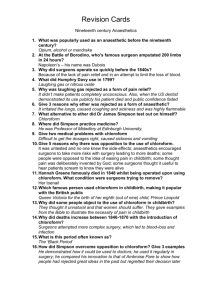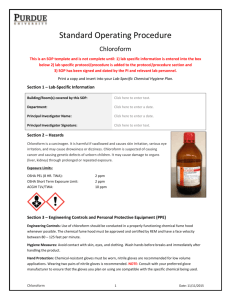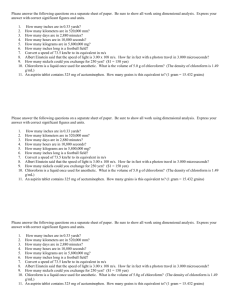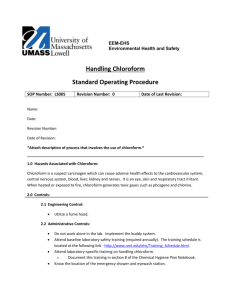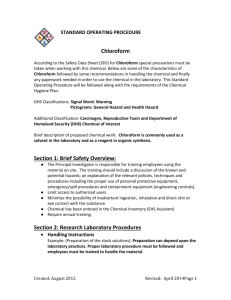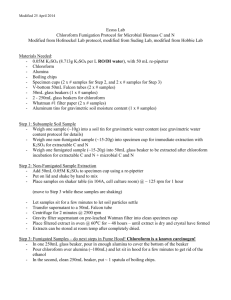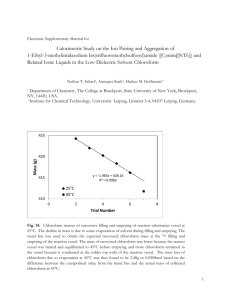Chloroform - EnviroTools
advertisement
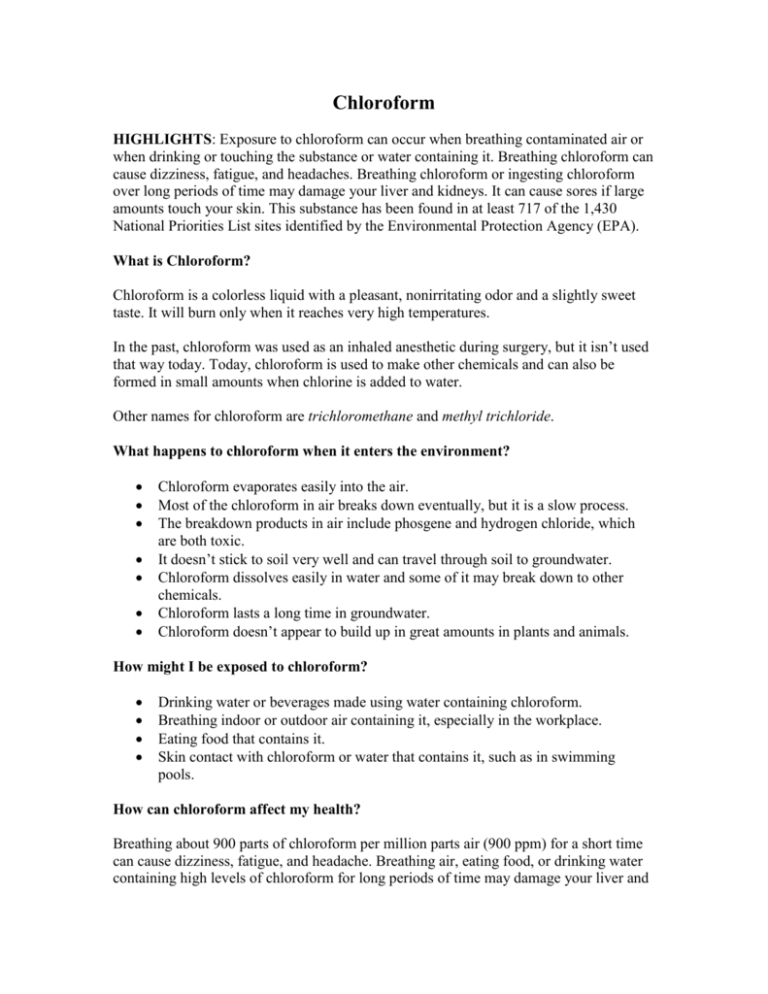
Chloroform HIGHLIGHTS: Exposure to chloroform can occur when breathing contaminated air or when drinking or touching the substance or water containing it. Breathing chloroform can cause dizziness, fatigue, and headaches. Breathing chloroform or ingesting chloroform over long periods of time may damage your liver and kidneys. It can cause sores if large amounts touch your skin. This substance has been found in at least 717 of the 1,430 National Priorities List sites identified by the Environmental Protection Agency (EPA). What is Chloroform? Chloroform is a colorless liquid with a pleasant, nonirritating odor and a slightly sweet taste. It will burn only when it reaches very high temperatures. In the past, chloroform was used as an inhaled anesthetic during surgery, but it isn’t used that way today. Today, chloroform is used to make other chemicals and can also be formed in small amounts when chlorine is added to water. Other names for chloroform are trichloromethane and methyl trichloride. What happens to chloroform when it enters the environment? Chloroform evaporates easily into the air. Most of the chloroform in air breaks down eventually, but it is a slow process. The breakdown products in air include phosgene and hydrogen chloride, which are both toxic. It doesn’t stick to soil very well and can travel through soil to groundwater. Chloroform dissolves easily in water and some of it may break down to other chemicals. Chloroform lasts a long time in groundwater. Chloroform doesn’t appear to build up in great amounts in plants and animals. How might I be exposed to chloroform? Drinking water or beverages made using water containing chloroform. Breathing indoor or outdoor air containing it, especially in the workplace. Eating food that contains it. Skin contact with chloroform or water that contains it, such as in swimming pools. How can chloroform affect my health? Breathing about 900 parts of chloroform per million parts air (900 ppm) for a short time can cause dizziness, fatigue, and headache. Breathing air, eating food, or drinking water containing high levels of chloroform for long periods of time may damage your liver and kidneys. Large amounts of chloroform can cause sores when chloroform touches your skin. It isn’t known whether chloroform causes reproductive effects or birth defects in people. Animal studies have shown that miscarriages occurred in rats and mice that breathed air containing 30 to 300 ppm chloroform during pregnancy and also in rats that ate chloroform during pregnancy. Offspring of rats and mice that breathed chloroform during pregnancy had birth defects. Abnormal sperm were found in mice that breathed air containing 400 ppm chloroform for a few days. How likely is chloroform to cause cancer? The Department of Health and Human Services (DHHS) has determined that chloroform may reasonably be anticipated to be a carcinogen. Rats and mice that ate food or drank water with chloroform developed cancer of the liver and kidneys. Is there a medical test to show whether I've been exposed to chloroform? Although the amounts of chloroform in the air that you exhale and in blood, urine, and body tissues can be measured, there is no reliable test to determine how much chloroform you have been exposed to or whether you will experience any harmful effects. The measurement of chloroform in body fluids and tissues may help to determine if you have come into contact with large amounts of chloroform, but these tests are useful for only a short time after you are exposed. Chloroform in your body might also indicate that you have come into contact with other chemicals. Has the federal government made recommendations to protect human health? The EPA drinking water limit for total trihalomethanes, a class of chemicals that includes chloroform, is 100 micrograms per liter of water (100 µg/L). The EPA requires that spills or accidental releases of 10 pounds or more of chloroform into the environment be reported to the EPA. The Occupational Safety and Health Administration (OSHA) has set the maximum allowable concentration of chloroform in workroom air during an 8-hour workday in a 40-hour workweek at 50 ppm. This factsheet was adapted from ATSDR. Last updated September 2002
